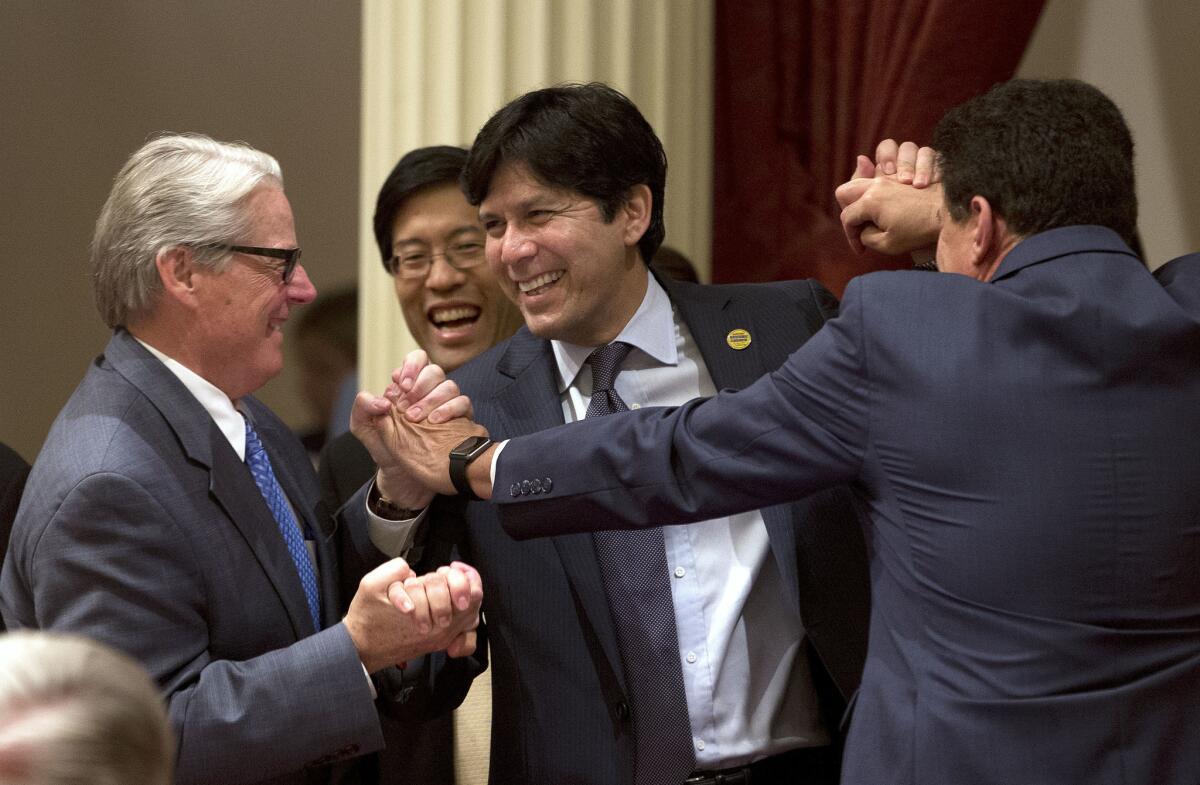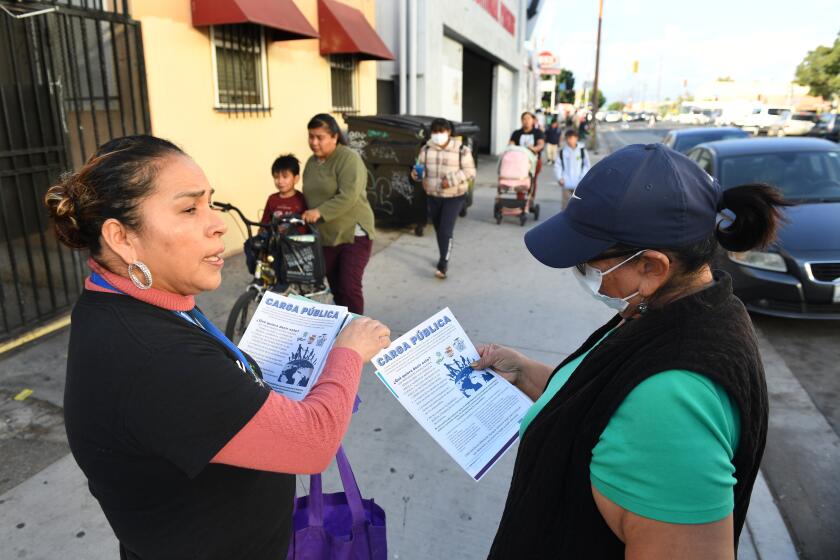The GOP is trying to kill California’s new private-sector retirement plan. State officials vow to push ahead

- Share via
Despite a setback in Washington last week, California leaders say they will push ahead with their plan for a state-run retirement program — a move that sets the stage for a legal battle with businesses, trade groups and possibly federal regulators.
Business and investment trade groups have lobbied hard against the state plans, which offer retirement savings accounts to private-sector workers who don’t have access to one through their jobs.
Federal guidelines that offered legal protection to the plans are on the verge of being revoked after a
One of the key points of contention could be over whether employees who enroll in the California Secure Choice program and similar plans are doing so on a “completely voluntary” basis.
Why a state-run plan?
The dozen or so states that have been developing publicly run retirement savings plans are aiming at workers whose employers don’t offer a pension or 401(k) accounts.
Nationwide, about 39 million workers aren’t offered a savings plan through work, according to the Department of Labor. Though workers can set up retirement savings plans on their own, most Americans don’t, with only about 10% of all workers contributing to a plan outside of work.
That will leave many Americans to rely only on Social Security income in retirement. For many workers, that won’t be enough.
The National Institute on Retirement Security estimated in 2013 that Americans had collectively saved at least $6.8 trillion less than they will need in retirement.

California Senate President Pro Tem Kevin de León (D-Los Angeles), the author of the bill establishing California’s Secure Choice retirement savings program, said last year that his aunt, a housekeeper, never saved for retirement and now depends on him for help.
“My aunt had to keep working until her body physically gave out. She relies on me as her 401(k) to help her through her retirement,” he said. “Nearly 50% of middle-income workers are at real risk of sliding into poverty when they can no longer work.”
California’s plan
The California plan was created last year when the state Legislature approved a bill that requires all companies with at least five employees either to offer their own private retirement savings plan or participate in the California Secure Choice program.
It’s estimated that as many as 6.8 million Californians will be eligible for the program. Workers would make automatic contributions of between 2% and 5% of their paycheck to a Secure Choice account in their name.
Employers would be required to give workers information about the program and to pass along employee contributions to the state. Unlike a 401(k) plan, employers would not be able to contribute to workers’ Secure Choice accounts.
The program will be overseen by a state board, part of the California Treasurer’s office, but investments likely will be managed by an outside firm.
Many details have yet to be decided, and the program is not expected to start enrolling workers until late next year or early 2019.
Once enrollment starts, companies with fewer than 100 workers will have two years either to offer plans of their own or sign up for Secure Choice. Companies with fewer than 50 employees would have three years to enroll.
What’s the big deal?
Lots of groups don’t like the idea of California Secure Choice and similar public plans.
- The Securities Industry and Financial Markets Assn., a trade group for Wall Street firms, has argued that public plans amount to unfair competition that would “crowd out” private retirement savings plans.
- The Investment Company Institute, a trade group for firms that manage mutual funds, has argued that employers who already offer a retirement savings plan to their workers might switch to public plans — a move that would save costs for employers but that also would mean less payout for workers.
- The U.S. Chamber of Commerce has argued that the creation of various state plans, all of which could have slightly different rules, would be a burden, especially for companies that employ workers in multiple states.
- The Chamber also argues that if something goes wrong with public plans, workers might try to sue employers under the Employee Retirement Income Security Act, or ERISA, a federal law that governs employee retirement programs and requires employers to follow a raft of rules.
That last point is a concern for states, too, and lawmakers have said they want to make sure that the public plans are not governed by ERISA.
If they’re subject to the federal law, these plans could come with lots of cost and liability for employers, said Marcia Wagner, a Boston attorney who specializes in ERISA issues.
“Companies would have a lot of requirements and obligations — they’d have to have a surety bond; they’d have to accept fiduciary responsibility,” she said. “These are issues small employers would prefer to avoid.”
So, states asked the Department of Labor, which enforces ERISA, to clarify that these new plans would not be subject to the law. The department did just that, finalizing a rule to that effect in October.
Uncertain legal footing?
Now, though, with the GOP in charge of all three branches of government, the Labor Department’s rule is on its way to the scrap heap. The House of Representatives in February passed a resolution to kill the rule, and the Senate followed suit last week.
The resolution must be approved by
Despite that, California and other states plan to push ahead, saying the Labor Department’s October rule was nice, but not strictly necessary.
“That was for the chambers of commerce to help them feel more confident that employers would not be subject to those rules,” said Katie Selenski, executive director of the California Secure Choice Retirement program. “We believe we’re still on firm legal footing. We will do whatever we need to do to help businesses feel confident that they are not going to be at risk.”
We believe we're still on firm legal footing.
— Katie Selenski, California Secure Choice
Selenski and others, including Dan Reeves, chief of staff to Secure Choice author de León, say a much older Labor Department rule gives enough legal protection for the plan to go forward.
A 1975 Labor Department guideline says that employers can direct employee contributions into an individual retirement account, or IRA, without that plan being governed by ERISA, as long as four conditions are met:
- The employer can invest only the employees’ money; it cannot make contributions of its own.
- The employer doesn’t select or endorse the IRA, but “acts as a mere facilitator” between the employee and the investment company offering the retirement account.
- The employer receives no payments, other than reimbursements for its own expenses.
- The employee’s participation in the IRA is “completely voluntary.”
Numbers 1, 2 and 3 are no problem for California’s Secure Choice program and similar plans, but No. 4 is where things could get tricky.
To auto enroll, or not
Backers of public plans generally want workers to be enrolled automatically — and to have to go out of their way to opt out. That’s how many private 401(k) programs work already.
But that kind of enrollment might not qualify as “completely voluntary.” The Labor Department has said that, under its 1975 guidance, the phrase was intended “to mean considerably more than that employees are free to opt out.”
A key element of the 2016 guidance was that automatic enrollment would not make the plans subject to ERISA, but if Trump signs the law overturning that guidance, the old rules will apply.
So if states include automatic enrollment as part of their plans, opponents could challenge in court. “I think that would be one issue people would hold up to say this is an ERISA plan,” said Aliya Wong, executive director for retirement policy at the U.S. Chamber of Commerce.
As the details of California’s plan are worked out, the specifics of enrollment will be a top issue, Selenski said.
“We are looking at the words ‘completely voluntary’ very carefully,” she said.
Reeves in de León’s office said the plan does not call for strictly automatic enrollment, which he believes may be enough to protect the plan from a challenge.

There is a potential downside, though, to this approach. A key advantage of automatic enrollment is that it leads to more people saving for retirement. According to investment giant Vanguard, workers are more than twice as likely to save for retirement if signed up automatically.
“From a behavioral economics perspective, it is absolutely preferred that it be strictly automatic with an opt-out,” Selenski said. “People tend not to undo the default.”
Get the L.A. Times Politics newsletter
Deeply reported insights into legislation, politics and policy from Sacramento, Washington and beyond. In your inbox twice per week.
You may occasionally receive promotional content from the Los Angeles Times.








